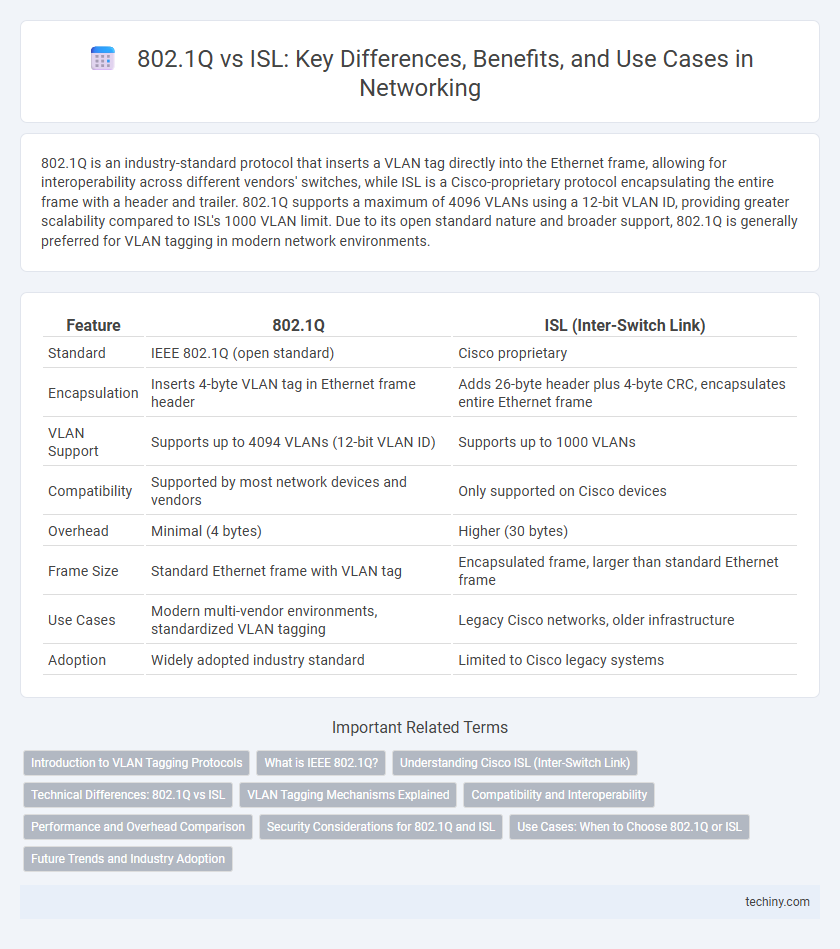802.1Q is an industry-standard protocol that inserts a VLAN tag directly into the Ethernet frame, allowing for interoperability across different vendors' switches, while ISL is a Cisco-proprietary protocol encapsulating the entire frame with a header and trailer. 802.1Q supports a maximum of 4096 VLANs using a 12-bit VLAN ID, providing greater scalability compared to ISL's 1000 VLAN limit. Due to its open standard nature and broader support, 802.1Q is generally preferred for VLAN tagging in modern network environments.
Table of Comparison
| Feature | 802.1Q | ISL (Inter-Switch Link) |
|---|---|---|
| Standard | IEEE 802.1Q (open standard) | Cisco proprietary |
| Encapsulation | Inserts 4-byte VLAN tag in Ethernet frame header | Adds 26-byte header plus 4-byte CRC, encapsulates entire Ethernet frame |
| VLAN Support | Supports up to 4094 VLANs (12-bit VLAN ID) | Supports up to 1000 VLANs |
| Compatibility | Supported by most network devices and vendors | Only supported on Cisco devices |
| Overhead | Minimal (4 bytes) | Higher (30 bytes) |
| Frame Size | Standard Ethernet frame with VLAN tag | Encapsulated frame, larger than standard Ethernet frame |
| Use Cases | Modern multi-vendor environments, standardized VLAN tagging | Legacy Cisco networks, older infrastructure |
| Adoption | Widely adopted industry standard | Limited to Cisco legacy systems |
Introduction to VLAN Tagging Protocols
802.1Q is the IEEE standard for VLAN tagging that inserts a 4-byte tag into Ethernet frames to identify VLAN membership, enabling interoperability across different vendors' equipment. ISL (Inter-Switch Link), a Cisco proprietary protocol, encapsulates entire Ethernet frames with a header and trailer for VLAN tagging, limiting compatibility outside Cisco environments. 802.1Q is widely adopted due to its standardization and efficiency, while ISL is primarily used in legacy Cisco networks.
What is IEEE 802.1Q?
IEEE 802.1Q is a networking standard that defines VLAN tagging for Ethernet frames, enabling multiple VLANs to coexist on a single physical switch port. This protocol inserts a 4-byte tag into the Ethernet frame header, specifying the VLAN ID and priority information for traffic management. It is widely supported and standardized, allowing interoperability across different vendors and devices in VLAN environments.
Understanding Cisco ISL (Inter-Switch Link)
Cisco ISL (Inter-Switch Link) is a proprietary VLAN tagging protocol developed by Cisco to encapsulate Ethernet frames for VLAN identification across switches. Unlike the IEEE 802.1Q standard which inserts a VLAN tag into the Ethernet frame, ISL encapsulates the entire frame with a new header and trailer, increasing overhead but maintaining compatibility with older Cisco devices. ISL supports multiple VLANs on a single physical link but is limited to Cisco environments, making 802.1Q the preferred choice for mixed vendor networks due to its open standard nature.
Technical Differences: 802.1Q vs ISL
802.1Q is an IEEE standard protocol that inserts a 4-byte VLAN tag into the Ethernet frame, supporting up to 4096 VLANs and preserving the original frame format. ISL (Inter-Switch Link) is a Cisco proprietary protocol that encapsulates the entire Ethernet frame with a 26-byte header and CRC, supporting up to 1000 VLANs but modifying the frame structure. While 802.1Q allows for native VLANs and interoperates across multiple vendor devices, ISL is limited to Cisco environments and does not support native VLAN tagging.
VLAN Tagging Mechanisms Explained
802.1Q and ISL are two VLAN tagging mechanisms used in Ethernet networking to identify and separate VLAN traffic. 802.1Q inserts a 4-byte tag into the Ethernet frame header, allowing interoperability across different vendors and supporting up to 4096 VLANs. ISL, a Cisco proprietary protocol, encapsulates the entire Ethernet frame with a 26-byte header and trailer but offers limited compatibility and is largely deprecated in favor of the IEEE 802.1Q standard.
Compatibility and Interoperability
802.1Q is an IEEE standard for VLAN tagging widely supported across multi-vendor networking equipment, ensuring broad compatibility and interoperability. ISL, a Cisco proprietary protocol, limits interoperability to Cisco devices, reducing flexibility in mixed-vendor environments. Deploying 802.1Q facilitates seamless VLAN communication across diverse hardware, while ISL is best suited for Cisco-centric networks.
Performance and Overhead Comparison
802.1Q offers superior performance over ISL by utilizing a smaller 4-byte VLAN tag compared to ISL's 26-byte header, resulting in reduced frame overhead and improved bandwidth efficiency. The compact 802.1Q tag minimizes latency and allows for higher throughput, making it more suitable for modern high-speed networks. ISL's larger header increases frame size, which can lead to greater processing delays and decreased overall network performance.
Security Considerations for 802.1Q and ISL
802.1Q provides robust VLAN tagging with native support for VLAN security features such as VLAN access control lists (ACLs) and BPDU guard, enhancing protection against VLAN hopping attacks. ISL, being a proprietary protocol, offers VLAN isolation but lacks widespread security enhancements and interoperability, raising concerns in heterogeneous network environments. Network administrators prefer 802.1Q for its standardized security measures and compatibility with various vendors, ensuring comprehensive VLAN segregation and minimizing unauthorized access risks.
Use Cases: When to Choose 802.1Q or ISL
802.1Q is the preferred VLAN tagging protocol for most modern networks due to its broad compatibility with various vendors and native support in Ethernet switches, making it ideal for heterogeneous environments and interoperability. ISL, a Cisco-proprietary protocol, is best utilized in legacy Cisco-only networks where backward compatibility with older devices is required. Choosing between 802.1Q and ISL depends on network infrastructure, device compatibility, and the need for standardization versus proprietary features.
Future Trends and Industry Adoption
802.1Q has become the dominant VLAN tagging standard due to its open-source nature and widespread support among network vendors, driving broader industry adoption. ISL, a proprietary Cisco protocol, is gradually being phased out in favor of 802.1Q because of its interoperability limitations and lack of support outside Cisco environments. Future trends indicate increasing emphasis on 802.1Q enhancements, such as support for VXLAN and software-defined networking (SDN) integration, ensuring its continued relevance in modern enterprise and data center networks.
802.1Q vs ISL Infographic

 techiny.com
techiny.com